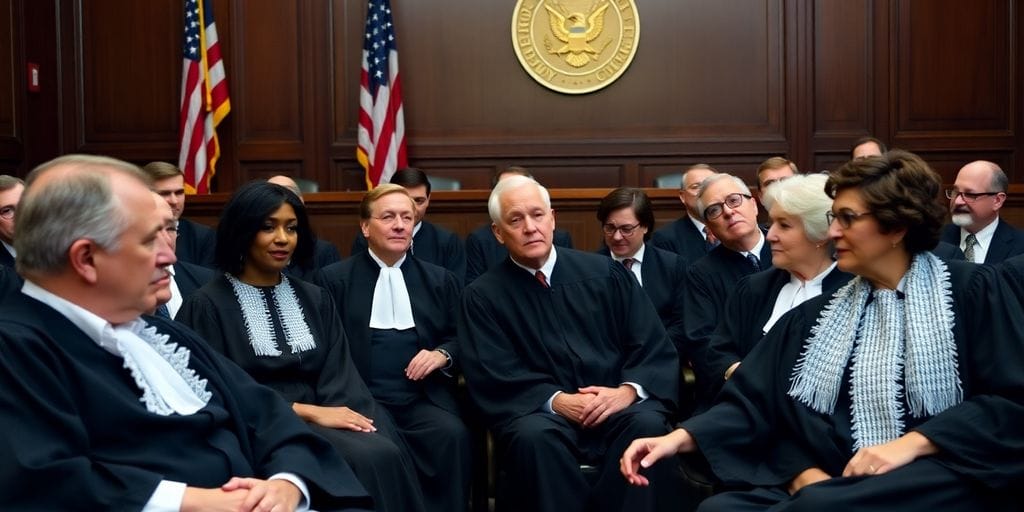Discover how U.S. immigration policy evolved, shaped by history, economy, and reform efforts balancing security and humanitarian concerns.
Key Takeaways
- Immigration policy in the USA has evolved significantly from colonial times to the present day.
- Key legislative milestones have shaped the current immigration landscape, including the 1952 and 1965 Acts.
- Immigration has profound economic impacts, influencing labor markets and contributing to economic growth.
- Social and cultural dimensions of immigration policy affect integration and community building.
- Contemporary challenges in immigration policy include managing unauthorized immigration and balancing security with humanitarian concerns.
Immigration policy in the USA has always been a hot topic. From the early days of the colonies to the bustling era of industrialization, and through the economic woes of the Great Depression, how America deals with newcomers has shaped the nation. Today, the conversation continues, focusing on how to balance security, economic needs, and humanitarian concerns. This article dives into the history, impacts, and future opportunities for reforming immigration policy in the USA, offering insights into the ongoing debates and potential paths forward.
Key Takeaways
Immigration policy in the USA has evolved significantly from colonial times to the present day.
Key legislative milestones have shaped the current immigration landscape, including the 1952 and 1965 Acts.
Immigration has profound economic impacts, influencing labor markets and contributing to economic growth.
Social and cultural dimensions of immigration policy affect integration and community building.
Contemporary challenges in immigration policy include managing unauthorized immigration and balancing security with humanitarian concerns.
Historical Context of Immigration Policy in the USA
Colonial Beginnings and Early Legislation
Immigration in the USA traces its roots back to the colonial period, where settlers arrived in search of new opportunities and religious freedom. The early years were marked by a relatively open-door policy, as the vast, unexplored lands required a workforce for development. However, as the colonies grew, so did the need for more structured immigration policies. The first significant legislative action came in the late 18th century with the Naturalization Act of 1790, which established the criteria for citizenship, primarily favoring free white persons.
The Impact of the Industrial Revolution
The Industrial Revolution brought about a massive demand for labor, leading to a surge in immigration. Between the mid-1800s and the early 20th century, millions of immigrants, particularly from Europe, flocked to the United States. This period saw the implementation of laws aimed at regulating the influx, such as the Chinese Exclusion Act of 1882. Industrialization not only transformed the American economy but also reshaped its demographic landscape, creating a melting pot of cultures and ethnicities.
Immigration Policy During the Great Depression
The Great Depression of the 1930s significantly altered the course of U.S. immigration policy. With the economy in shambles and unemployment at an all-time high, the country saw a dramatic reduction in immigration numbers. The era was characterized by stringent immigration controls, as the government sought to protect domestic jobs. This period also witnessed the implementation of the national-origins quota system, which aimed to restrict immigration from certain regions, reflecting the prevailing sentiments of economic nationalism and protectionism.
Understanding the historical context of immigration policy in the USA reveals a complex interplay between economic needs, social dynamics, and political agendas. Each era brought its own challenges and solutions, shaping the nation’s approach to immigration in profound ways.
Key Legislative Milestones in U.S. Immigration Policy
The Immigration and Nationality Act of 1952
The Immigration and Nationality Act of 1952, also known as the McCarran-Walter Act, was a significant piece of legislation that reshaped the landscape of U.S. immigration policy. This act upheld the existing quota system, which favored immigrants from Northern and Western Europe, while introducing a preference system for skilled workers and relatives of U.S. citizens. Despite its attempts to modernize immigration policy, the act was criticized for maintaining discriminatory national origins quotas, which many felt were outdated and unfair.
The 1965 Immigration and Nationality Act Amendments
In 1965, Congress enacted amendments to the Immigration and Nationality Act, marking a pivotal shift in U.S. immigration policy. These amendments abolished the national origins quota system, replacing it with a preference system that prioritized family reunification and attracted skilled immigrants. As a result, the demographics of immigration changed dramatically, with more individuals arriving from Asia and Latin America instead of Europe. This legislation not only increased the annual number of immigrants but also set the stage for future discussions on immigration reform.
Recent Legislative Efforts and Reforms
In the decades following the 1965 amendments, several key legislative efforts were made to address the challenges of unauthorized immigration and refugee admissions. The Immigration Reform and Control Act of 1986 provided a pathway to legalization for millions of undocumented immigrants while imposing penalties on employers hiring unauthorized workers. The 1990 Immigration Act further expanded immigration levels and introduced the diversity visa lottery to promote diversity among immigrants. More recently, legislative efforts have focused on balancing security concerns with humanitarian needs, as seen in the Refugee Act of 1980, which increased refugee admissions to align with international standards. Despite these efforts, immigration policy remains a contentious and evolving issue, with ongoing debates about the best path forward.
Economic Impacts of Immigration Policy in the USA
Labor Market Dynamics and Immigration
Immigration plays a big role in shaping the labor market in the United States. With a steady influx of immigrants, the workforce is constantly evolving. Immigrants contribute significantly by filling essential roles across various sectors, from agriculture to technology. They often take on jobs that are hard to fill, helping to keep industries running smoothly. Plus, they bring diverse skills that enrich the American labor pool. However, there’s always a debate about how immigration affects wages and job availability for native-born workers. Some argue it leads to competition for jobs, while others point out that immigrants often complement the native workforce, taking on roles that others might not.
The Role of High-Skilled Immigrants
High-skilled immigrants are a crucial part of the U.S. economy. They bring specialized knowledge and expertise, especially in fields like science, technology, engineering, and mathematics (STEM). This group helps drive innovation and keeps the U.S. competitive on a global scale. Companies often rely on high-skilled immigrants to fill gaps in the workforce, especially in tech and research sectors. However, the process to bring these skilled workers into the country can be challenging, with visa caps and lengthy application processes. Despite these challenges, the demand for high-skilled immigrants remains high, highlighting their importance in maintaining economic growth.
Economic Contributions of Migrants
Migrants contribute to the economy in many ways. They pay taxes, spend money on goods and services, and help to sustain local businesses. According to most economists, immigration positively impacts the US economy by expanding the labor force, enhancing tax revenue, and increasing consumer spending. These contributions are crucial, especially in areas with shrinking populations. Migrants also play a key role in entrepreneurship, starting businesses that create new jobs and stimulate economic activity. Their presence helps to revitalize communities and bring fresh perspectives to the American economic landscape.
Immigration is more than just a policy issue; it’s a vital part of the economic fabric of the nation. The contributions of immigrants, both skilled and unskilled, are essential to sustaining growth and innovation in the U.S. economy.
Social and Cultural Dimensions of Immigration Policy
Integration and Community Building
Creating a welcoming environment for immigrants is crucial for fostering integration and building strong communities. Many cities across the U.S. have launched initiatives like community outreach programs and language access services. These efforts not only support immigrants but also encourage positive interactions with local residents. A well-integrated community can thrive economically and socially, benefiting everyone involved.
Cultural Diversity and Social Cohesion
Immigration brings a rich tapestry of cultures, enriching the social fabric of the nation. However, balancing cultural diversity with social cohesion can be challenging. Inclusive policies and practices are essential in promoting mutual respect and understanding among different cultural groups. This balance helps in reducing tensions and fostering a harmonious society.
Challenges of Assimilation
Assimilation poses its own set of challenges as immigrants strive to adapt to new cultural norms while maintaining their own heritage. This process can be complicated, often requiring support in areas like education and employment. The key is to find a middle ground where immigrants feel they belong without losing their cultural identity.
In the end, embracing cultural diversity while ensuring social cohesion is not just beneficial but necessary for a vibrant and dynamic society.
Contemporary Challenges in U.S. Immigration Policy
Addressing Unauthorized Immigration
Dealing with unauthorized immigration is a major hurdle for U.S. policymakers. The sheer number of undocumented immigrants—estimated at over 10 million—poses significant social, economic, and legal challenges. The U.S. has grappled with finding a balance between enforcement and humanitarian approaches. While some advocate for stricter border controls and deportations, others push for pathways to legalization and integration.
Balancing Security and Humanitarian Concerns
Security is a top priority in immigration policy, especially post-9/11. Yet, there’s a constant struggle to balance these concerns with humanitarian needs. The U.S. has faced criticism for policies perceived as overly harsh, such as family separations and travel bans targeting specific countries. On the flip side, there are calls for more compassionate policies that protect vulnerable groups, like asylum seekers and refugees.
The Political Landscape and Policy Debates
Immigration is a hot-button issue in American politics, often dividing opinion along party lines. Debates rage over border security, the DREAM Act, and DACA, with little consensus in sight. Political gridlock often stalls comprehensive reform efforts, leaving many issues unresolved. The result is a patchwork of policies that are frequently subject to change with each new administration.
Immigration policy in the U.S. is a complex and often contentious topic. With competing interests and values at play, finding common ground remains a daunting task.
Opportunities for Reforming Immigration Policy in the USA
Innovative Policy Solutions and Initiatives
The U.S. is at a crossroads when it comes to immigration policy. With a growing economy and 8 million job openings, there’s a pressing need for reform. One fresh idea is the “bridge visa,” which would let American companies sponsor foreign workers, giving them a path to residency after six years. This visa isn’t just for high-skilled workers; it’s open to all skill levels, making it a flexible option for both circular migration and permanent residency. Another exciting proposal is the “startup visa,” aimed at foreign entrepreneurs eager to build businesses in the U.S., potentially creating up to 1.6 million jobs over a decade.
Pathways to Legalization and Citizenship
Creating clear and fair pathways to legalization and citizenship is crucial. Streamlining the process for immigrants who contribute to the economy and society can help integrate them more fully into American life. Expanding labor pathways and sponsorships are steps in the right direction, but they need thorough testing to ensure they meet the needs of both immigrants and the communities they join. Localities can act as testing grounds for these new policies, providing valuable insights into what works best.
Harnessing Immigration for Economic Growth
Immigration has always been a driver of economic growth in the U.S. By reforming policies to better align with economic needs, the country can continue to thrive. Place-based visas are one such innovation, allowing states and cities to tailor immigration programs to local industry demands. This could lead to more equitable distribution of immigrants across the country, ensuring that areas in need of labor can attract the workforce they require.
Immigration policy reform isn’t just about changing laws; it’s about recognizing the potential for growth and integration that immigrants bring to the table. With thoughtful and inclusive reforms, the U.S. can harness this potential to build a more prosperous future for everyone.
Conclusion
So, here we are, at the end of our journey through the twists and turns of U.S. immigration policy. It’s been quite a ride, hasn’t it? From the early days when the country was just figuring out how to handle newcomers, to the complex and sometimes messy system we have today. We’ve seen how politics, economics, and social changes have all played a part in shaping the rules and regulations. And while it’s clear that the system isn’t perfect, there’s hope. With ongoing debates and new ideas, there’s a chance to make things better. Maybe one day, we’ll find a balance that works for everyone. Until then, the conversation continues, and who knows what the future holds?
Frequently Asked Questions
What is the history of immigration laws in the USA?
Immigration laws in the USA have changed a lot over time. From the colonial days to now, laws have been made to control who can come and stay in the country. Important changes happened in 1965 when the laws became more open to people from all over the world.
How do immigrants impact the economy of the USA?
Immigrants help the economy by filling jobs, bringing new skills, and starting businesses. They work in many different fields and help grow the economy by paying taxes and spending money on goods and services.
What are some challenges with current immigration policies?
Today’s immigration policies face challenges like dealing with unauthorized immigration and balancing security with helping people in need. The political debates make it hard to find solutions that everyone agrees on.
Why is it hard to change immigration laws?
Changing immigration laws is tough because of political disagreements and the complex nature of the system. Many people have different opinions on how immigration should be handled, making it hard to pass new laws.
What are some opportunities for improving immigration policy?
There are chances to make immigration laws better by finding new solutions, creating paths to citizenship, and using immigration to boost economic growth. These changes could help make the system fairer and more efficient.
How does immigration affect American society and culture?
Immigration brings cultural diversity and helps build communities. While it adds to the richness of American society, it also brings challenges like helping newcomers fit in and ensuring social unity.



